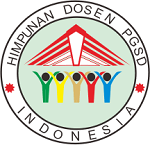MEDIA PEMBELAJARAN KOGERBE (KOTAK GERAK BENDA) PADA MATERI GERAK BENDA MATA PELAJARAN IPA KELAS IV SEKOLAH DASAR
DOI:
https://doi.org/10.24114/jgk.v4i4.20349Abstract
Abstract: Learning Media Kogerbe (Box Motion Objects) on Object Motion Material for Class IV Elementary School Science Subjects. This study aims to develop learning media Kogerbe (Box Motion Objects) and to determine the feasibility of learning media Kogerbe (Box Motion Objects) on the subject matter Motion Objects Science Subject in grade IV SD Negeri 105335 Kebun Sayur. This research is a research and development or Research and Development (R&D). The development model used in this research is the ADDIE model using 5 steps, namely (analysis), design (design), development (development), implementation (implementation) and evaluation (evaluation). Validation was carried out by two experts, namely learning media experts and material experts and field testing (student responses). The results showed that the average score of media experts was 4.3 with a percentage of 85% in the category of "Very Good" and "Very Feasible". Furthermore, the average score of the material experts was 4.4 with a feasibility percentage of 88% which was included in the Very Good andœ Very Appropriate categories. It is included in the "Very Good" and "Very Appropriate" categories. Based on the overall results, it can be concluded that the Kogerbe learning media (Object Motion Box) can be developed and is suitable for use as a science learning media on object motion material for grade IV SD.Keywords: Learning Media, Kogerbe, ScienceAbstrak: Media Pembelajaran Kogerbe (Kotak Gerak Benda) Pada Materi Gerak Benda Mata Pelajaran IPA Kelas IV Sekolah Dasar. Penelitian ini bertujuan untuk mengembangkan media pembelajaran Kogerbe (Kotak Gerak Benda) serta mengetahui kelayakan media pembelajaran Kogerbe (Kotak Gerak Benda) pada materi Gerak Benda Mata Pelajaran IPA di kelas IV SD Negeri 105335 Kebun Sayur. Penelitian ini merupakan penelitian dan pengembangan atau Research and Development (R&D). Model pengembangan yang digunakan pada penelitian ini adalah model ADDIE dengan menggunakan 5 langkah yaitu (analysis), desain (design), pengembangan (development), implementasi (implementation) dan evaluasi (evaluation). Validasi dilakukan oleh dua ahli yaitu ahli media pembelajaran dan ahli materi dan uji lapangan (respon peserta didik). Hasil penelitian menunjukkan rata-rata perolehan nilai dari ahli media 4,3 dengan persentase kelayakan sebesesar 85% termasuk dalam kategori œSangat Baik dan œSangat Layak. Selanjutnya rata-rata perolehan nilai dari ahli materi 4,4 dengan persentase kelayakan sebesar 88 % termasuk dalam kategori Sangat Baik dan œSangat Layak Pada saat uji coba produk rata-rata perolehan nilai dari siswa 4,8 dengan persentase kelayakaan sebesar 96% termasuk dalam kategori œSangat Baik dan œSangat Layak Bedrasarkan hasil keseluruhan maka dapat disimpulkan media pembelajaran Kogerbe (Kotak Gerak Benda) dapat dikembangkan dan layak digunakan sebagai media pembelajaran IPA pada materi gerak benda kelas IV SD. Kata Kunci : Media Pembelajaran, Kogerbe, IPADownloads
Published
2020-10-21
How to Cite
Siadari, C., & Ananda, L. J. (2020). MEDIA PEMBELAJARAN KOGERBE (KOTAK GERAK BENDA) PADA MATERI GERAK BENDA MATA PELAJARAN IPA KELAS IV SEKOLAH DASAR. JGK (Jurnal Guru Kita), 4(4), 62–67. https://doi.org/10.24114/jgk.v4i4.20349
Issue
Section
Articles
License
Authors published with the JGK (Jurnal Guru Kita) agree to the following terms:
- Authors retain copyright and grant the journal the right of first publication with the work simultaneously licensed under a Creative Commons Attribution License (CC BY-SA 4.0) that allows others to share the work with an acknowledgment of the work's authorship and initial publication in this journal.
- Authors are able to enter into separate, additional contractual arrangements for the non-exclusive distribution of the journal's published version of the work (e.g., post it to an institutional repository or publish it in a book), with an acknowledgment of its initial publication in this journal.
- Authors are permitted and encouraged to post their work online (e.g., in institutional repositories or on their website) prior to and during the submission process, as it can lead to productive exchanges, as well as earlier and greater citation of published work. (See The Effect of Open Access)


























